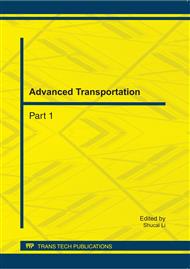p.458
p.463
p.471
p.475
p.480
p.485
p.489
p.494
p.498
Influence of the Moving Bottleneck on the Traffic Flow on Expressway
Abstract:
The mix rate of large trucks is extremely high on expressway in China. The influence of moving bottleneck on the traffic flow of the expressway is particularly serious. The moving bottleneck, formed due to the overtaking of the low-speed trucks, is analyzed with the kinematic wave theory and simulated by utilizing the VISSIM software. Simulation results indicate that increase of the traffic flow and the mix rate of trucks could aggravate the influence of the moving bottleneck on the traffic states, and decrease the speeds of cars significantly. This leads to the insufficient use of the expressway resources. The study result can contribute to the traffic capacity analysis of the expressway.
Info:
Periodical:
Pages:
480-484
Citation:
Online since:
September 2011
Authors:
Keywords:
Price:
Сopyright:
© 2011 Trans Tech Publications Ltd. All Rights Reserved
Share:
Citation:


